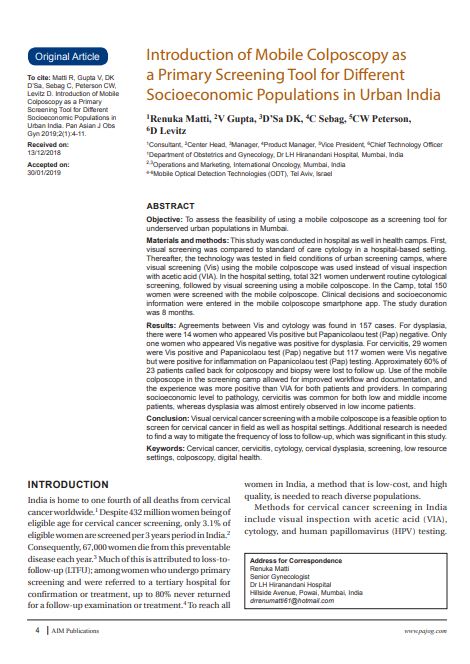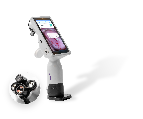READ THE ORIGINAL ARTICLE AT THE PANASIAN JOURNAL OF OBSTETRICS AND GYNECOLOGY>
Objective: To assess the feasibility of using a mobile colposcope as a screening tool for underserved urban populations in Mumbai.
Materials and methods: This study was conducted in hospital as well in health camps. First, visual screening was compared to standard of care cytology in a hospital-based setting. Thereafter, the technology was tested in field conditions of urban screening camps, where visual screening (Vis) using the mobile colposcope was used instead of visual inspection with acetic acid (VIA). In the hospital setting, total 321 women underwent routine cytological screening, followed by visual screening using a mobile colposcope. In the Camp, total 150 women were screened with the mobile colposcope. Clinical decisions and socioeconomic information were entered in the mobile colposcope smartphone app. The study duration was 8 months.
Results: Agreements between Vis and cytology was found in 157 cases. For dysplasia, there were 14 women who appeared Vis positive but Papanicolaou test (Pap) negative. Only one women who appeared Vis negative was positive for dysplasia. For cervicitis, 29 women were Vis positive and Papanicolaou test (Pap) negative but 117 women were Vis negative but were positive for inflammation on Papanicolaou test (Pap) testing. Approximately 60% of 23 patients called back for colposcopy and biopsy were lost to follow up. Use of the mobile colposcope in the screening camp allowed for improved workflow and documentation, and the experience was more positive than VIA for both patients and providers. In comparing socioeconomic level to pathology, cervicitis was common for both low and middle income patients, whereas dysplasia was almost entirely observed in low income patients.
Conclusion: Visual cervical cancer screening with a mobile colposcope is a feasible option to screen for cervical cancer in field as well as hospital settings. Additional research is needed to find a way to mitigate the frequency of loss to follow-up, which was significant in this study.








